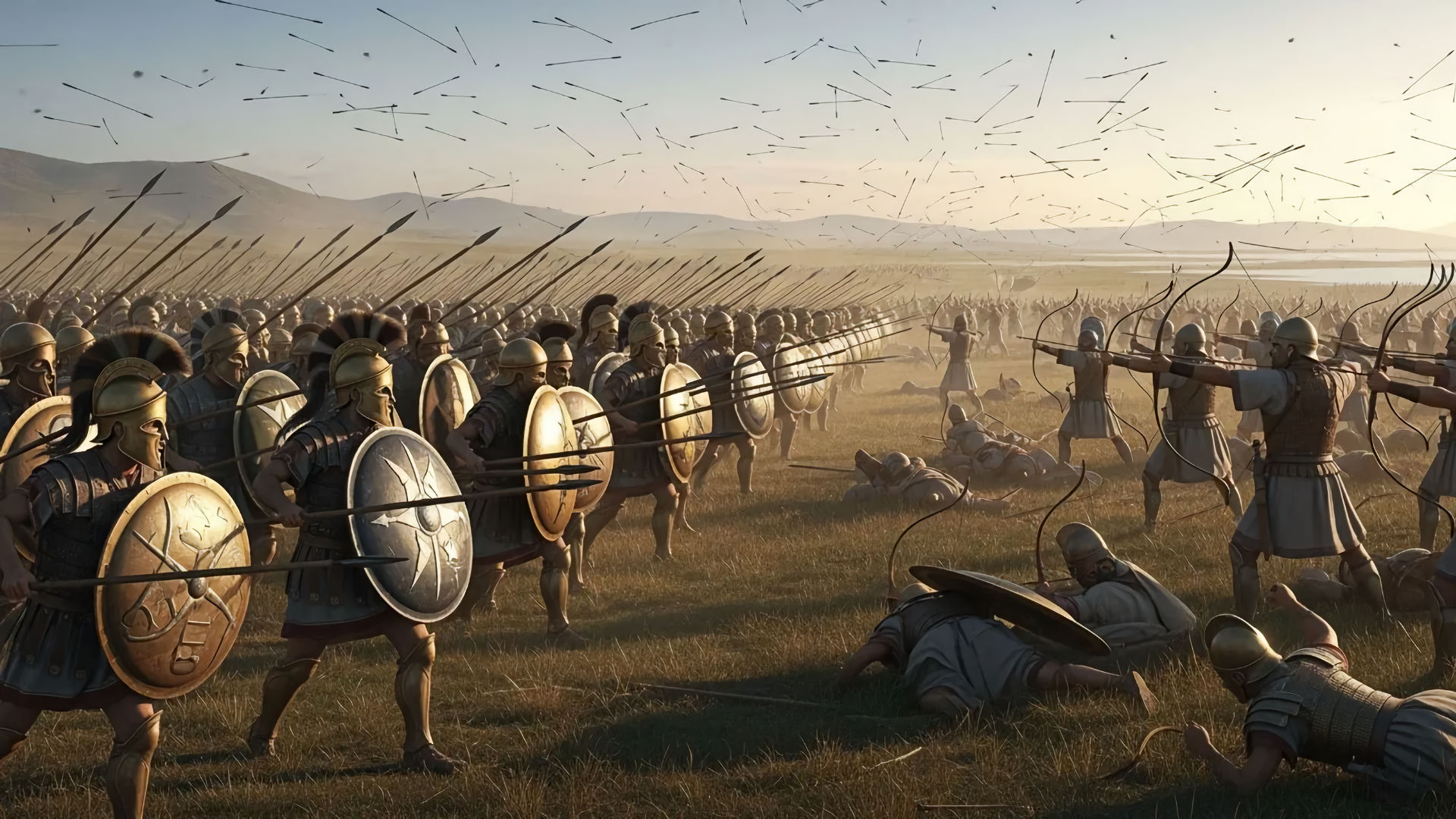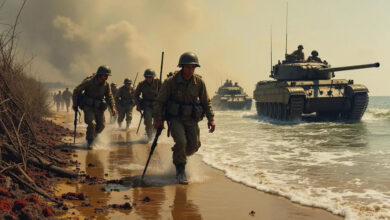The Battle of Marathon
The Battle of Marathon took place in 490 BCE during the first Persian invasion of Greece. It was the culmination of a chain of events that began with the Ionian Revolt, when Greek cities along the coast of Asia Minor rebelled against Persian rule and received limited support from Athens and Eretria. After the revolt was crushed, King Darius I resolved to punish the offending mainland cities and to bring the Greek world more firmly within the Persian sphere. A punitive expedition sailed across the Aegean, subduing islands in its path, before landing on the Marathon plain in north-eastern Attica. What followed became one of the defining clashes of the classical age, remembered for a bold tactical plan, a rapid infantry assault, and a result that carried immense political weight.
Forces and Commanders
The Persian force was led by Datis and Artaphernes, experienced generals with a fleet using the protected anchorage along Marathon’s long sandy bay. Persian strengths lay in numbers, archery, and mobility. Their core infantry fought with wicker shields, spears, and bows, supported by contingents from subject peoples. Persian cavalry was a serious threat in open country, able to harry infantry lines and break formations if gaps appeared.
The Athenians, under a board of ten strategoi and the polemarch Callimachus, mustered a citizen army of hoplites. These were heavily armed foot soldiers with bronze helmets, corselets or linen armour, greaves, the large round aspis shield, and thrusting spears. Miltiades, a former tyrant of the Chersonese and a veteran of Persian affairs, argued for decisive action. Athens received crucial support from the small city of Plataea in Boeotia, whose hoplites marched to join their Athenian allies. Sparta, famed for military prowess, was delayed by religious observance and did not arrive in time for the battle itself.
The Ground at Marathon
Marathon is a broad plain backed by low hills and closed on its seaward side by a long beach and marshes. Two passes lead inland toward Athens. For hoplite infantry, the ground offered room to deploy, while marshy patches and hedged farms could impede cavalry. The Persians established a camp near the shore where their ships lay beached. The Athenians positioned themselves between the Persian army and the inland passes, using the hills to anchor their flanks. This stance forced the invaders either to attack the Greek line head-on or to attempt an embarkation and sail around Attica to strike Athens directly.
Debate and Decision
Athenian leaders argued over whether to risk battle. Some favoured watching and waiting, hoping for Spartan arrival. Miltiades insisted that delay would embolden the enemy and risk a Persian move by sea against the city. The deciding vote fell to Callimachus, who sided with Miltiades. According to later accounts, the Greeks also learned that Persian cavalry had, at least for a time, re-embarked on the transports, perhaps to manoeuvre elsewhere or to water the horses away from the front. Whether entirely accurate or not, the hoplite commanders judged there was a window to strike before Persian mounted troops could play their full part.
Greek Deployment
Miltiades adopted a formation that traded depth in the centre for strength on the wings. The Athenian and Plataean contingents formed three broad blocks: a thinner centre that would hold and bend under pressure, and thicker wings intended to drive in the Persian flanks. This was unusual for a citizen army accustomed to equal files, but it reflected a clear assessment of strengths. The hoplite edge in close combat would be most telling where their line could overlap lighter Persian infantry. If the wings broke through, they could wheel inward and crush the Persian centre.
The Charge
The Greeks advanced across the plain at a brisk pace. Tradition celebrates a run, but even a swift trot over hundreds of metres in armour would have been punishing. The key point is that the Athenians reduced the time spent under arrow fire and reached hand-to-hand distance while their cohesion held. Persian archers loosed volleys, yet the heavy shields and armour of the hoplites blunted the worst. When the lines met, the contrast between equipment and fighting style became decisive. Hoplite phalanxes pushed with shields and spears in a dense mass. Persian infantry, brave but less protected, struggled to halt the weight of the charge.
Crisis in the Centre
As Miltiades expected, the thinner Greek centre was driven back by the stronger Persian middle, where elite units may have been posted. For a moment, the battle hung in the balance. On the wings, however, the Athenians and Plataeans broke the opposing lines. Once the flanks collapsed, the Greek wings pivoted inward against the Persian centre. With pressure now coming from the front and sides, cohesion in the Persian ranks began to fail. The fight devolved into pockets of resistance and attempts to withdraw toward the shore.
Retreat and Rout
Many Persian soldiers fell back toward the marshes and the beached ships. Marshy ground and channels trapped men who tried to flee in armour or who became separated from their comrades. Greek pursuit reached the surf line where desperate struggles erupted around the vessels. The Athenians captured or burned several ships, though many Persian crews managed to push off and row for deeper water under covering fire from archers. The fight at the shoreline was costly. Callimachus, the Athenian polemarch whose vote had enabled battle, was killed near the ships, and other notable citizens fell in the final crush.
Numbers and Losses
Ancient figures for troop strengths vary widely, often wildly. A reasonable modern view places the Greek hoplites at roughly ten thousand Athenians and perhaps one thousand Plataeans. Persian numbers may have been at least twice that on the field, with more troops aboard their transports. Casualty estimates reported by Herodotus give the Greeks just under two hundred dead and the Persians in the thousands. Exact counts cannot be proved, yet the disparity is plausible given the nature of the rout and the fact that heavily armed victors tend to inflict disproportionate losses on a broken foe.
Immediate Aftermath
Once the surviving Persian forces re-embarked, their fleet sailed south, then around Cape Sounion, apparently aiming for Phaleron or another landing near Athens. The Athenians recognised the danger. Leaving a detachment to guard the field and tend to the dead, the hoplites marched rapidly back across Attica to interpose themselves between the city and the sea. The Persian fleet arrived to find Athenian ranks drawn up and ready. Whether discouraged by this sight or constrained by time and supply, the Persians did not force a new landing and sailed away toward Asia Minor, raiding as they went.
Burial and Memory
On the Marathon plain, the Athenians raised a tumulus, the Soros, over the bodies of their fallen comrades. The burial mound, along with a victory trophy and inscriptions, turned the field into a place of civic memory. Each year, sacrifices and games honoured the dead. The Plataeans received particular recognition for their loyalty, and Marathon entered Athenian political life as proof that citizen soldiers, led by elected commanders, could defeat the might of an empire. The battle became a touchstone in public speech, invoked by statesmen to rally confidence in later crises.
Pheidippides and the Marathon Run
The most famous story attached to Marathon is the messenger who ran to Athens to announce victory, collapsed, and died after gasping out a single word. The core of the tale likely blends two episodes reported by ancient sources. Herodotus records that an Athenian runner named Pheidippides ran to Sparta before the battle to seek help, an astonishing distance over mountain roads. Later writers associated a post-battle run to Athens with the birth of the modern marathon race. The legend captures a truth about the campaign even if its details are embroidered. Speed of communication and the rapid march back to defend Athens were crucial to transforming a field victory into strategic success.
Why the Greeks Won
Several elements shaped the outcome. The Athenians fought as a cohesive citizen army on terrain that limited the advantage of Persian cavalry. The hoplite phalanx, compact and heavily protected, was well suited to a decisive close-quarters push. Miltiades’ deployment, thickening the wings and accepting risk in the centre, turned a potential weakness into an operational plan. Initiative mattered. The decision to attack before Persian mounted troops could intervene removed a key threat. Persian bravery and numbers could not compensate for the difficulty of stopping an armoured charge without firm protection or solid obstacles.
Persian Perspectives
It would be wrong to view Marathon as a humiliation that the Persian Empire could not absorb. The campaign had already punished Eretria, which was sacked and its people deported. The fleet remained powerful, and the empire vast. Yet the failure to subdue Athens forced a reconsideration of methods. A second invasion would come a decade later under Xerxes, with a far larger multinational force and a more deliberate strategy. Marathon did not end Persian ambitions in Greece, but it proved that the vaunted imperial army could be checked by a city that organised quickly, chose its ground, and fought with discipline.
Political Consequences in Athens
The victory bolstered the prestige of the hoplite class and strengthened the hand of leaders who advocated a more assertive Athenian policy. It also fed rivalry. Miltiades was briefly celebrated, then prosecuted for failures in a later expedition and died of wounds. Over the next decade, Athenian politics would swing toward naval power. The discovery of silver at Laurion and the rise of Themistocles shifted investment from hoplite levies to trireme fleets. Marathon remained glorious in memory, but the future of Athenian strength would rest increasingly on oars, docks, and sea walls.
Archaeology and the Field Today
The Marathon plain preserves reminders of the battle. The Soros still rises over the site of the Athenians’ communal grave. Excavations have revealed pottery, arrowheads, and traces of the Persian camp. The marshlands have changed with time, yet the relationship between hills, fields, and shore remains legible. Visitors can understand why the Athenians chose their position and how the battle unfolded toward the beach. The landscape is modest rather than spectacular, which suits a battle decided less by grand geography than by timing, cohesion, and a ruthless push at the right moment.
Tactics and the Evolution of Warfare
Marathon showcases a classic infantry solution to a mixed-arms threat. Persian forces excelled in archery and cavalry. The Greeks neutralised those strengths by compressing the space for manoeuvre and by closing quickly to negate sustained missile fire. The battle also illustrates how citizen formations can innovate within tradition. The hoplite phalanx was not a fixed doctrine. Adjusting depth across the line and aiming for an encirclement rather than a straight shove shows tactical flexibility. Later Greek commanders would apply similar principles in other contexts, just as Persian commanders would learn to combine arms more effectively against heavy infantry.
Wider Greek Morale and Identity
News of Marathon resonated across the Greek world. The notion that free citizens had checked the forces of a great king nourished a narrative of Hellenic identity that would only grow during the later Persian Wars. City-states still quarrelled and sometimes fought one another, yet in embassies and festivals, Marathon became a symbol of common achievement. Even critics of Athenian ambition acknowledged the scale of the feat. In drama, sculpture, and public ritual, Marathon joined the pantheon of episodes that framed how Greeks of the fifth century BCE understood themselves.
Enduring Myths and Measured History
The memory of Marathon has been embroidered with heroic stories, from the sprinting messenger to the idea that the Athenian army ran the entire distance in armour. Popular imagination does this to every famous battle. The historian’s task is not to strip away meaning but to identify the core that explains the outcome. At Marathon, the core is clear. A citizen army, led by commanders with intimate knowledge of Persian methods, seized a fleeting advantage, exploited the ground, and used a robust infantry system to crack a larger host. The result was a battlefield victory that had strategic effects far beyond the casualties counted in the surf.
Final Word The Battle of Marathon was more than a clash on a coastal plain. It was a test of political nerve, tactical judgement, and the capacity of a small state to face an imperial power. The Athenians chose to fight at a moment that favoured them, accepted risk to create opportunity, and turned a rapid advance into a rolling collapse of the enemy line. Persian forces recovered and returned in greater strength years later, which reminds us that single victories seldom settle grand struggles. Yet Marathon mattered as proof of concept and as a spark. It showed that disciplined infantry could beat a composite army that relied on arrows and cavalry, and it gave the Greek world a story of resistance that would carry through the battles of Thermopylae, Salamis, and Plataea. On that plain between hills and sea, the citizens of a young democracy wrote themselves into history with a charge that still echoes across time.
The Battle of Marathon FAQ
A clash in 490 BCE during the first Persian invasion of Greece, fought on the Marathon plain in Attica between Athenian and Plataean hoplites and a Persian expeditionary force.
They chose ground that limited cavalry, advanced quickly to reduce time under arrows, and used a formation with strong wings that broke the Persian flanks and then rolled up the centre.
The Athenians were led by a board of strategoi with Miltiades prominent and the polemarch Callimachus holding the deciding vote. The Persian force was commanded by Datis and Artaphernes.
Athens preserved its independence, boosted civic confidence, and set the stage for wider Greek resistance in the later Persian Wars, while Persia regrouped for a larger invasion a decade later.






